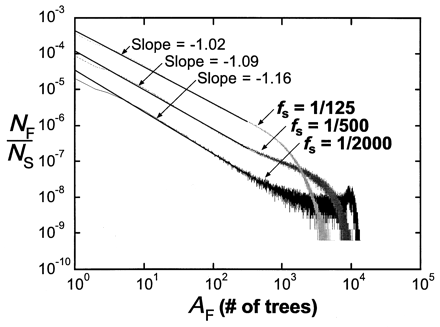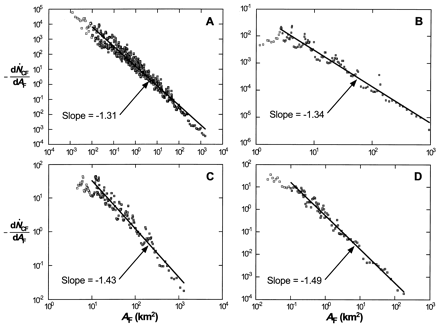What Can the Forest Fire Model Tell Us About the Behavior of Actual Forest Fires?
In class recently we have discussed the ubiquitous nature of power laws in describing the distribution of many different phenomena. One example given in class was the number of websites with a particular number of in-links had a distribution proportional to 1/(# in-links)^2. This discussion reminded me of an article I came across in my research, which focuses on the forest fire component of climate models. A paper published back in 1998 described a way to evaluate the effectiveness of “the forest fire model” at predicting the size distribution of actual fires seen in observations. The model they were referencing was actually quite simple, and is described in full detail in the paper (Malamud, Morein, and Turcotte, 1998). The basic premise is that there is a two dimensional grid on which trees can be planted. At each timestep an attempt to plant a tree is made at a random gridbox. If a tree already exists at the selected gridbox, then nothing happens, but if a tree does not exist at the gridbox, the tree is planted. After a certain number of timesteps, governed by the “match frequency,” a match is dropped randomly on the grid. If the match lands on a gridbox that contains a tree, a fire starts. Otherwise nothing happens. Once a fire starts, it burns the tree in the gridbox where it started and spreads to all adjacent trees (to the north, south, east, or west). The fire continues to spread until there are no more trees it can burn. In other words until it reaches the boundary of the forest. The model can be run for millions or billions of timesteps to obtain smooth frequency-area distributions that are robustly correlated to power laws with an exponent of -1 to -1.2.
After fitting the frequency-area distributions of observations to a power law, the researchers saw exponents in the -1.3 to -1.5 range. Clearly these exponents were greater in magnitude than those seen in the model. This means that large fires were more frequent in reality than in the model.
The model experiments were somewhat interesting. When we look more closely at the results, we see that as the match frequency decreased, the magnitude of the exponent in the power law increased. This is a somewhat intuitive result. If the the match frequency decreases, that means that there is more time for large forests to develop. When it comes time for a match to drop again, these forests cover a large area and are thus more likely to be set on fire. This results in a larger proportion of large fires in comparison to runs with higher match frequencies. As noted in the article, this phenomenon speaks to the benefits of controlled burns in controlling the frequency of large, damaging fires. If we are diligent in preventing the available fuel sources from getting too large by increasing the frequency of small fires, we can decrease the chance that there will be a large destructive fire.
As it turns out, “the forest fire model” is something that has been extensively studied in the applied math realm. It in fact has strong ties to networks. To motivate this model’s connection to networks I would say that we can imagine a tree like a node in a network, but it can only link to a maximum of four other trees. The connections between trees form groups. These groups of linked trees can be viewed as components that can be large or small (i.e. forests) that determine the resulting sizes of fires. We would also expect to see a sort of the “rich get richer” phenomenon in that it would be more likely for a tree to be planted adjacent to a large forest, rather than two or three linked trees, because the large components have more available links. The fact that one can imagine forests as components of linked trees and that there is a definite rich get richer trend makes this example very similar to other networks related models governed by power laws.
-__________


